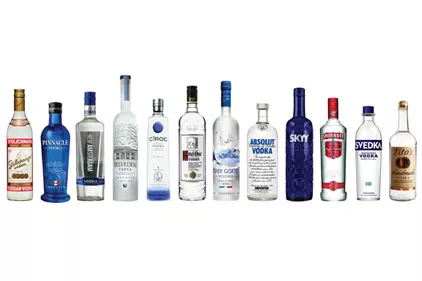Packaging
Top shelf test
New package audit shows how design helps or hinders spirits makers.

Image source: Affinnova Inc.
Vodka has become the backbone of the US spirits industry, with 65.2 million 9-liter cases sold in 2012, accounting for 32 percent of the total sales of the US spirits market and generating $5.5 billion in revenue, according to a report from the Distilled Spirits Council of the United States.
“Numerous studies have shown consumers become attached to a vodka brand due to marketing and advertising rather than the quality of the actual product. Plus, we know consumers make their purchase decisions at the shelf more than 50 percent of the time,” says Blake Howard, senior vice president of design solutions at Affinnova, a global marketing technology company.
“On-shelf competition for vodka has never been higher, but most consumer goods companies are not paying close enough attention to their package design, and we want to illustrate that,” says Howard, whose company recently released key findings in its first Package Design Audit that focused on vodka.
“Few products have as intense of a competitive landscape as vodka, a market seeing double-digit growth rates. Powered by Affinnova’s technology platform, the design audit provides insight into how package design helps or hurts the brand. The audit can be used for food and beverage packaging as well as other market segments.”
Affinnova’s vodka audit included 500 US-based vodka drinkers who evaluated the top 12 vodka brands in the US for shelf impact, design personality and design aesthetics. Half the consumers were asked about the brand name while the other participants answered questions about the packaging design.
The report revealed the brands consumers most associated with a particular personality attribute; the package design that gained the most attention on the shelf; and areas on the package that affected brand perception positively or negatively. Qualitative consumer critiques were created, illustrating the creative elements on the package that resonated positively or negatively.
Affinnova selected 11 design personality traits most commonly associated with the vodka category—sophisticated, traditional, celebratory, sexy, intelligent, friendly, approachable, fun, trusted, modern and genuine. Responses from the participants formed the basis of every vodka brand’s ranking in each category.
Each package design’s ranking was compared against the consumers’ perceptions of the brand. “Not surprisingly, there is often a very wide gap between existing brand perception on the whole and perception of the package on the shelf. A wide gap often indicates the need for a package redesign to better align with existing brand personality traits,” explains Howard.
In addition to screening participants and having them complete a brand or packaging design evaluation, Affinnova’s methodology included a web-based eye tracking test which follows eye movement over a package and measures the time spent viewing elements and areas of the package. The Affinnova technology platform takes various measurements, both quantitatively and qualitatively. Optimization algorithms, predictive analytics and other tools show which packaging does best. A special “click-and-comment” feature allows participants to select individual design elements on the package they like the most or least, and lets them add freeform comments. Affinnova’s technology detects the zones of interest and triggers analysis. The system generates a word cloud from the feedback, filtering the language most commonly used to describe a given brand.
The report yielded insights on how the three top vodka brands—Grey Goose, Absolut and Smirnoff—stacked up. Grey Goose’s bottle design performed above average for visibility—with consumers looking at the package in the first four seconds and focusing on the packaging longer than the baseline time. Absolut brand performed well on the shelf with an above average score, but several key personality traits, including its view as sexy, fun or modern, dragged down the brand. Smirnoff was associated as being sexy by women but not men.
In addition, Affinnova’s packaging audit revealed Generation X’ers and Baby Boomers don’t see eye to eye with Millennials when viewing the same package. Consequently, producers should determine if their package design will position them for growth within an older generation or it’s resonating with a younger demographic. The audit also showed why some newer brands are winning on the shelf (e.g., bolder design, color or elements) and why bad packaging spells brand erosion. Using its technology platform, Affinnova can identify the packaging that will perform best in the market using its design optimizer and design benchmarker software tools.
For more information:
Jason Keith, Affinova Inc., 781-464-4709, jkeith@affinnova.com
Looking for a reprint of this article?
From high-res PDFs to custom plaques, order your copy today!





